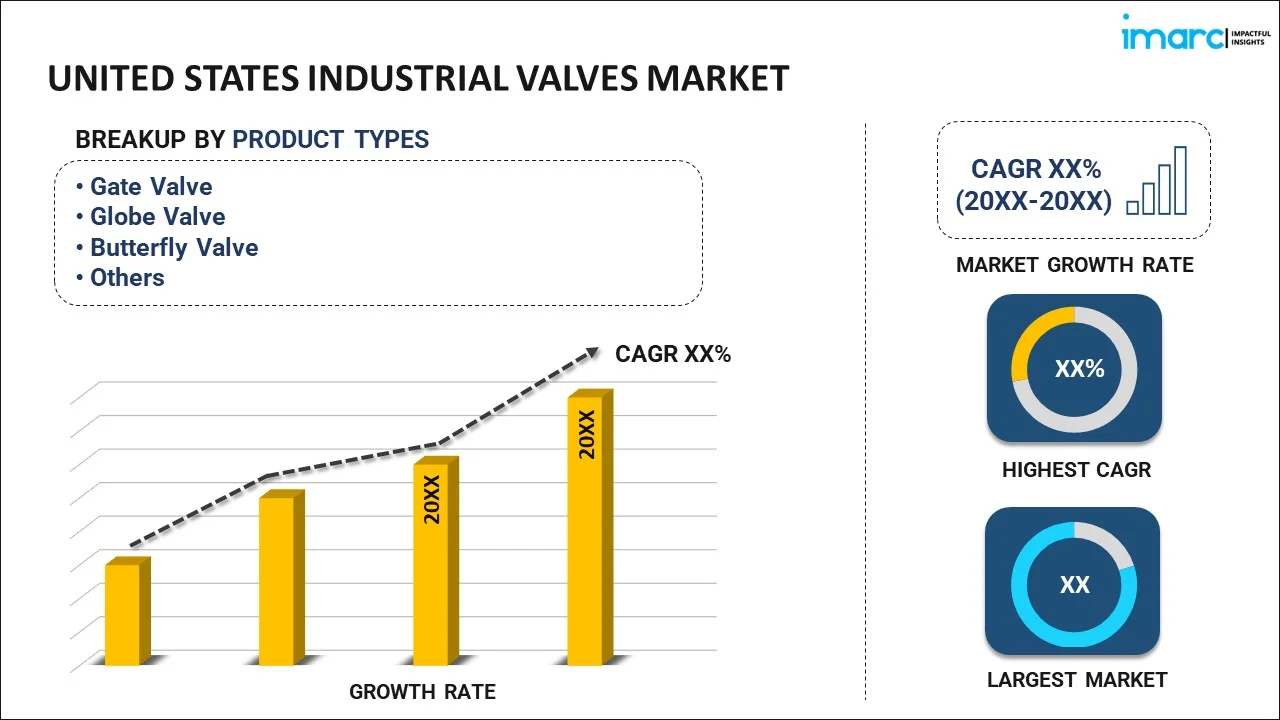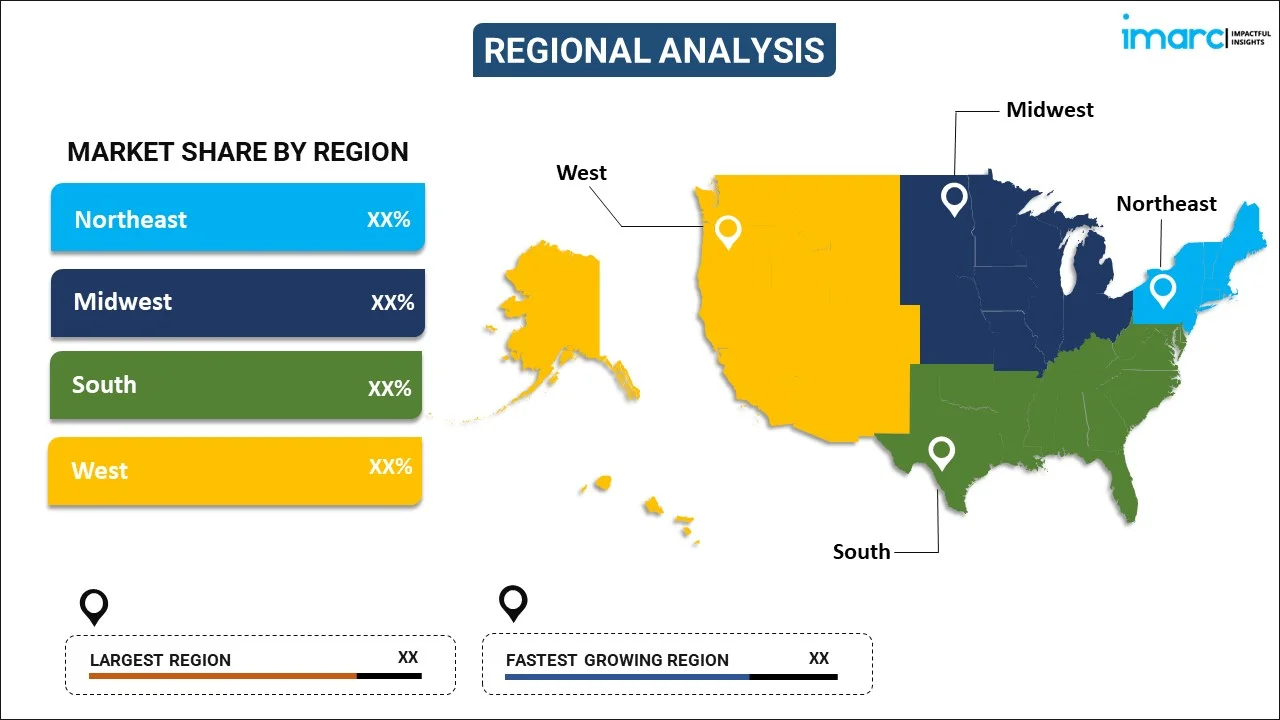
United States Industrial Valves Market Report by Product Type (Gate Valve, Globe Valve, Butterfly Valve, Ball Valve, Check Valve, Plug Valve, and Others), Functionality (On-Off/Isolation Valves, Control Valves), Material (Steel, Cast Iron, Alloy Based, and Others), Size (Up to 1”, 1”-6”, 7”-25”, 26”-50”, 51” and Above), End Use Industry (Oil and Gas, Power, Pharmaceutical, Water and Wastewater Treatment, Chemical, Food and Beverage, and Others), and Region 2025-2033
Market Overview:
United States industrial valves market size reached USD 11.4 Million in 2024. Looking forward, IMARC Group expects the market to reach USD 15.8 Million by 2033, exhibiting a growth rate (CAGR) of 3.63% during 2025-2033. The ongoing process of industrialization, which leads to increased demand for industrial valves across various sectors such as oil and gas, chemicals, power generation, and water and wastewater treatment, is driving the market.
|
Report Attribute
|
Key Statistics
|
|---|---|
|
Base Year
|
2024
|
|
Forecast Years
|
2025-2033
|
|
Historical Years
|
2019-2024
|
|
Market Size in 2024
|
USD 11.4 Million |
|
Market Forecast in 2033
|
USD 15.8 Million |
| Market Growth Rate 2025-2033 | 3.63% |
United States Industrial Valves Market Analysis:
- Key Market Drivers: Increased industrialization in oil and gas, chemicals, and power industries propels demand for effective fluid control systems. Regulatory environmental standards require sophisticated valve technologies for emissions management and resource conservation. Infrastructure renewal programs and industrial automation trends further support further market growth through rising valve deployment needs.
- Key Market Trends: Integration of intelligent technologies such as IoT sensors and automation improves valve monitoring abilities. Sustainability emphasis spurs creation of environmentally friendly valve materials and energy-saving designs. Digitalization allows for predictive maintenance solutions. Increased focus on precision control systems drives usage of advanced valve technologies in manufacturing processes.
- Competitive Structure: Market dominated by incumbent manufacturers with diversified product portfolios. Technology innovation, strategic alliances, and expansion across geographies are the strategies pursued to ensure competitive edge. Differentiation based on high-quality materials, intelligence, and customization options fuels market rivalry and strengthens customer value propositions.
- Challenges and Opportunities: Fluctuations in raw material costs and intricate regulatory demands create operational challenges. Still, growth of the renewable energy industry, infrastructure development plans, and increasing industrial automation offer strong growth opportunities. Steadily rising demand for specialist valves in new applications provides new market niches for creative solutions.
Industrial valves are essential components in various industrial processes, serving to control the flow of fluids or gases within pipelines. These valves play a crucial role in regulating, isolating, and directing the movement of substances in diverse applications, such as manufacturing, energy production, and water treatment. Industrial valves come in a variety of types, including gate valves, globe valves, ball valves, and butterfly valves, each designed for specific functions and conditions. They are pivotal in maintaining process efficiency, safety, and reliability by managing fluid flow and pressure. The selection of the appropriate valve depends on factors like the nature of the fluid, operating conditions, and the intended purpose. With advancements in technology, modern industrial valves often incorporate innovative materials and designs to enhance performance and durability, contributing to the seamless operation of industrial processes.
United States Industrial Valves Market Trends:
Increasing Industrial Need for Advanced Valve Systems
Increased industrial sophistication and demand for accurate fluid control are driving demand for advanced valve systems in the United States. As industries like oil and gas, chemical processing, power generation, and water treatment make use of more advanced operations, the need for good valves increases. Effective fluid management provides minimum downtime, higher productivity, and consistent operational safety, particularly in high-temperature and high-pressure applications. Industries are increasingly adopting automated valve solutions to improve workflows, track performance in real-time, and minimize human intervention. Further, the increasing focus on energy efficiency and process optimization is driving manufacturers to upgrade traditional valves with high-precision options that can perform to stringent operational specifications. This trend highlights the extent to which United States industrial valves market demand is increasingly driven by the changing needs of various industrial processes, setting the market up for steady growth as industries continue to value efficiency, reliability, and process control in operations.
Environmental Sustainability Driving Market Dynamics
Sustainability efforts and compliance regulations are increasingly determining the direction of valve uptake across industries. Valves that reduce leakage, lower emissions, and save energy are in greater demand from companies in an effort to meet strict environmental regulations. This is most important in the chemical, water treatment, and power generation industries, where wasted resources and operational risks can be the direct result of inefficient valves. The drive for sustainability has resulted in the advancement and implementation of low-leak, high-performance valves that can provide environmental compliance while delivering industrial productivity. Federal and state laws in the United States are also further encouraging investments in green technologies, pushing manufacturers to implement up-to-date valve systems that adhere to stringent standards. The emphasis on resource conservation, emissions reduction, and environmental accountability is thus fueling the United States industrial valves market share, emblematic of the accelerating convergence of regulatory constraints and industrial upgrading.
Technological Advancements and Smart Integration
Technological innovation is reshaping the functionality of valves in industrial uses, improving performance, longevity, and monitoring. Smart sensors, IoT connectivity, and automated control systems are combined to enable real-time tracking, predictive maintenance, and smooth adjustment of operations, minimizing downtime and maximizing efficiency. Advanced materials and precision engineering enhance the ruggedness of valves in extreme environments, including high-pressure pipelines and corrosive surroundings. Industries are increasingly leveraging these smart technologies to meet operational challenges while maintaining cost efficiency. Automation and digital integration have also simplified system management, allowing plant managers to control multiple valves remotely, analyze performance data, and implement preventive measures effectively. This intersection of industrial need and technological advancement is the focus of United States industrial valves market analysis, representing a future-oriented strategy in which technological innovation fuels market growth, operational efficiency, and the implementation of advanced solutions in contemporary industrial plants.
United States Industrial Valves Market Segmentation:
IMARC Group provides an analysis of the key trends in each segment of the market, along with forecasts at the country level for 2025-2033. Our report has categorized the market based on product type, functionality, material, size, and end use industry.
Product Type Insights:

To get more information on this market, Request Sample
- Gate Valve
- Globe Valve
- Butterfly Valve
- Ball Valve
- Check Valve
- Plug Valve
- Others
The report has provided a detailed breakup and analysis of the market based on the product type. This includes gate valve, globe valve, butterfly valve, ball valve, check valve, plug valve, and others.
Functionality Insights:
- On-Off/Isolation Valves
- Control Valves
A detailed breakup and analysis of the market based on the functionality have also been provided in the report. This includes on-off/isolation valves and control valves.
Material Insights:
- Steel
- Cast Iron
- Alloy Based
- Others
The report has provided a detailed breakup and analysis of the market based on the material. This includes steel, cast iron, alloy based, and others.
Size Insights:
- Up to 1”
- 1”-6”
- 7”-25”
- 26”-50”
- 51” and Above
A detailed breakup and analysis of the market based on the size have also been provided in the report. This includes up to 1”, 1”-6”, 7”-25”, 26”-50”, and 51” and above.
End Use Industry Insights:
- Oil and Gas
- Power
- Pharmaceutical
- Water and Wastewater Treatment
- Chemical
- Food and Beverage
- Others
The report has provided a detailed breakup and analysis of the market based on the end use industry. This includes oil and gas, power, pharmaceutical, water and wastewater treatment, chemical, food and beverage, and others.
Regional Insights:

- Northeast
- Midwest
- South
- West
The report has also provided a comprehensive analysis of all the major regional markets, which include Northeast, Midwest, South, and West.
Competitive Landscape:
The market research report has also provided a comprehensive analysis of the competitive landscape. Competitive analysis such as market structure, key player positioning, top winning strategies, competitive dashboard, and company evaluation quadrant has been covered in the report. Also, detailed profiles of all major companies have been provided.
United States Industrial Valves Market Report Coverage:
| Report Features | Details |
|---|---|
| Base Year of the Analysis | 2024 |
| Historical Period | 2019-2024 |
| Forecast Period | 2025-2033 |
| Units | Million USD |
| Scope of the Report | Exploration of Historical and Forecast Trends, Industry Catalysts and Challenges, Segment-Wise Historical and Predictive Market Assessment:
|
| Product Types Covered | Gate Valve, Globe Valve, Butterfly Valve, Ball Valve, Check Valve, Plug Valve, Others |
| Functionalities Covered | On-Off/Isolation Valves, Control Valves |
| Materials Covered | Steel, Cast Iron, Alloy Based, Others |
| Sizes Covered | Up to 1”, 1”-6”, 7”-25”, 26”-50”, 51” and Above |
| End Use Industries Covered | Oil and Gas, Power, Pharmaceutical, Water and Wastewater Treatment, Chemical, Food and Beverage, Others |
| Regions Covered | Northeast, Midwest, South, West |
| Customization Scope | 10% Free Customization |
| Post-Sale Analyst Support | 10-12 Weeks |
| Delivery Format | PDF and Excel through Email (We can also provide the editable version of the report in PPT/Word format on special request) |
Key Benefits for Stakeholders:
- IMARC’s industry report offers a comprehensive quantitative analysis of various market segments, historical and current market trends, market forecasts, and dynamics of the United States industrial valves market from 2019-2033.
- The research report provides the latest information on the market drivers, challenges, and opportunities in the United States industrial valves market.
- Porter's five forces analysis assist stakeholders in assessing the impact of new entrants, competitive rivalry, supplier power, buyer power, and the threat of substitution. It helps stakeholders to analyze the level of competition within the United States industrial valves industry and its attractiveness.
- Competitive landscape allows stakeholders to understand their competitive environment and provides an insight into the current positions of key players in the market.
Key Questions Answered in This Report
The industrial valves market in the United States was valued at USD 11.4 Million in 2024.
The United States industrial valves market is projected to exhibit a CAGR of 3.63% during 2025-2033, reaching a value of USD 15.8 Million by 2033.
The United States industrial valves market is driven by rising demand from the oil and gas, power generation, and water treatment sectors. Growing focus on infrastructure development, energy efficiency, and process automation further fuels adoption. Additionally, technological advancements in valve design and materials enhance durability, reliability, and operational performance across industries.
Need more help?
- Speak to our experienced analysts for insights on the current market scenarios.
- Include additional segments and countries to customize the report as per your requirement.
- Gain an unparalleled competitive advantage in your domain by understanding how to utilize the report and positively impacting your operations and revenue.
- For further assistance, please connect with our analysts.
 Request Customization
Request Customization
 Speak to an Analyst
Speak to an Analyst
 Request Brochure
Request Brochure
 Inquire Before Buying
Inquire Before Buying




.webp)




.webp)












